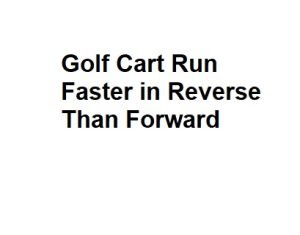Golf carts are a common sight on golf courses, used by players and maintenance staff for transportation. However, an interesting phenomenon has been observed in many golf carts – they tend to run faster in reverse than they do when moving forward. In this article, we will explore the reasons behind this peculiar occurrence and the potential implications.
1. Understanding the Mechanism:
- Transmission System: Most golf carts use a simple electric motor and a transmission system for propulsion. In a typical setup, the electric motor powers the wheels through a gearbox.
- Gearing Ratio: The gearing ratio in the transmission system can affect the speed of the golf cart. Different gears are used for forward and reverse movement.
2. Reverse Gear Ratio:
- Higher Gear Ratio: The reverse gear in a golf cart often has a higher gear ratio compared to the forward gears.
- Impact on Speed: A higher gear ratio means that for each rotation of the motor, the wheels turn more times in reverse than in forward. This results in a higher speed when the cart is in reverse.
3. Safety Considerations:
- Intentional Design: Golf carts are designed this way for safety reasons. When moving in reverse, it’s important for the vehicle to move at a slower speed to prevent accidents.
- Reduced Risk: Slower reverse speed reduces the risk of collisions and accidents, especially in crowded areas like golf courses or parking lots.
4. Regulatory Compliance:
- Compliance with Regulations: Many regions and municipalities have regulations in place that require golf carts to meet specific safety standards.
- Reverse Speed Limit: These regulations often include maximum speed limits, which typically apply to both forward and reverse motion. However, the reverse speed limit is usually set at a lower threshold to ensure safety.
5. Potential Modifications:
- Modifying the Gear Ratio: Some golf cart enthusiasts and owners may choose to modify the gear ratio to increase the forward speed.
- Caution Required: It’s important to note that modifying the gear ratio can have safety implications and may not be legal in all areas.
6. Practical Implications:
- Maneuverability: The ability to move at a slower pace in reverse is valuable for precise maneuvering on the golf course. This feature allows golfers and maintenance personnel to navigate tight spaces, such as between trees and around obstacles, with greater control.
- Parking and Loading: When loading golf clubs and equipment onto a cart or parking it near the clubhouse, the slower reverse speed provides added safety and control.
7. Electric vs. Gas-Powered Golf Carts:
- Transmission Variations: While the reverse-forward speed difference is common in electric golf carts, it’s worth noting that gas-powered carts may have different transmission systems with varying speed characteristics.
- Electric Advantages: Electric carts are popular due to their quieter operation, zero emissions, and ease of maintenance, making them a preferred choice for many golf courses.
8. Maintenance and Servicing:
- Regular Inspections: Owners and operators of golf carts should conduct regular maintenance and inspections to ensure the transmission system, including the gears and motors, is functioning correctly.
- Professional Service: Any modifications or repairs should be carried out by trained professionals to maintain the safety and reliability of the vehicle.
9. Innovation and Future Developments:
- Technology Advancements: As technology continues to evolve, future golf cart designs may incorporate more sophisticated transmission systems with variable speed control to enhance user experience while maintaining safety.
- Electric Vehicle Trends: With the growing interest in electric vehicles, there may be advancements in electric golf cart technology, including improvements in power delivery and efficiency.
Reasons for Faster Reverse Speed
| Reason | Explanation |
|---|---|
| Motor Design | Some golf carts are designed to have more power in reverse. |
| Controller Settings | Manufacturers may set the controller to deliver more power in reverse for safety reasons. |
| Traction | Reverse may provide better traction due to the weight distribution. |
| Gear Ratio | Gear ratios may be optimized for reverse speed. |
| Safety Considerations | Faster reverse speed can help golf carts avoid collisions. |
Safety Considerations for Faster Reverse Speed
| Safety Aspect | Explanation |
|---|---|
| Visibility | Ensure drivers have clear visibility when reversing. |
| Audible Signals | Implement audible signals to alert others when reversing. |
| Speed Control | Implement speed limits for reverse to ensure safety. |
| Warning Signs | Use warning signs in areas with golf cart traffic. |
| Training | Provide training to golf cart operators on reverse driving safety. |
Conclusion:
Understanding why golf carts run faster in reverse than forward is essential for both golfers and those responsible for maintaining and operating these vehicles. It’s a deliberate design choice that prioritizes safety and maneuverability. While modifications are possible for those seeking increased forward speed, caution must be exercised to comply with safety regulations and ensure the vehicle’s continued reliability and safety. As golf cart technology evolves, we may see innovations that provide even more control and customization for users while maintaining safety as a paramount concern.



